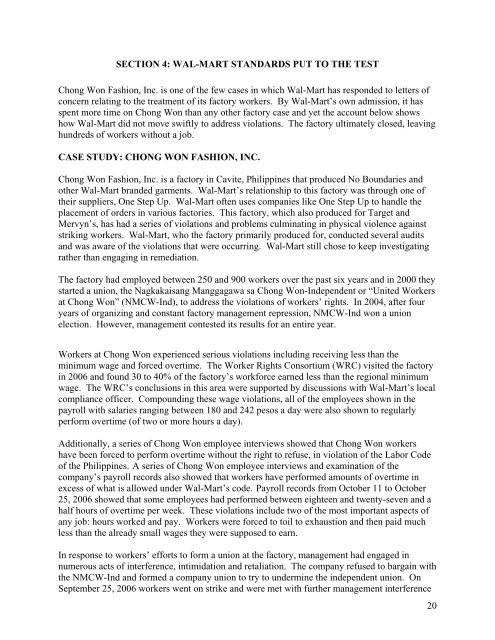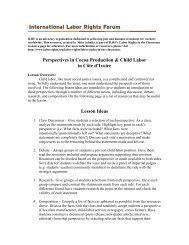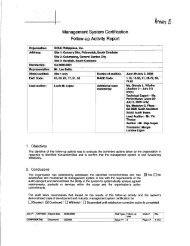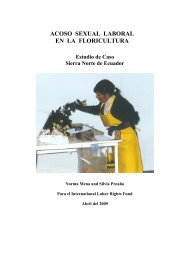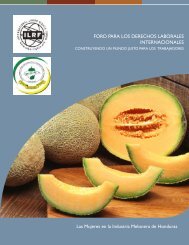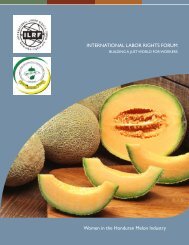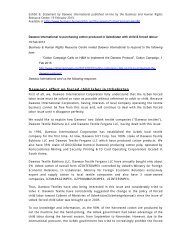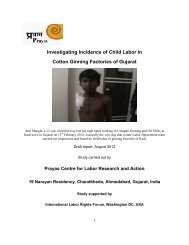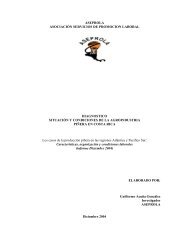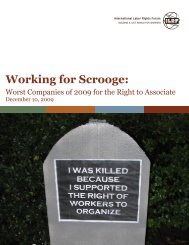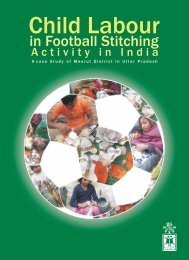SECTION 4: WAL-MART STANDARDS PUT TO THE TESTChong Won Fashion, Inc. is one of the few cases <strong>in</strong> which <strong>Wal</strong>-Mart has responded to letters ofconcern relat<strong>in</strong>g to the treatment of its factory workers. By <strong>Wal</strong>-Mart’s own admission, it hasspent more time on Chong Won than any other factory case <strong>and</strong> yet the account below showshow <strong>Wal</strong>-Mart did not move swiftly to address violations. The factory ultimately closed, leav<strong>in</strong>ghundreds of workers without a job.CASE STUDY: CHONG WON FASHION, INC.Chong Won Fashion, Inc. is a factory <strong>in</strong> Cavite, Philipp<strong>in</strong>es that produced No Boundaries <strong>and</strong>other <strong>Wal</strong>-Mart br<strong>and</strong>ed garments. <strong>Wal</strong>-Mart’s relationship to this factory was through one oftheir suppliers, One Step Up. <strong>Wal</strong>-Mart often uses companies like One Step Up to h<strong>and</strong>le theplacement of orders <strong>in</strong> various factories. This factory, which also produced for Target <strong>and</strong>Mervyn’s, has had a series of violations <strong>and</strong> problems culm<strong>in</strong>at<strong>in</strong>g <strong>in</strong> physical violence aga<strong>in</strong>ststrik<strong>in</strong>g workers. <strong>Wal</strong>-Mart, who the factory primarily produced for, conducted several audits<strong>and</strong> was aware of the violations that were occurr<strong>in</strong>g. <strong>Wal</strong>-Mart still chose to keep <strong>in</strong>vestigat<strong>in</strong>grather than engag<strong>in</strong>g <strong>in</strong> remediation.The factory had employed between 250 <strong>and</strong> 900 workers over the past six years <strong>and</strong> <strong>in</strong> 2000 theystarted a union, the Nagkakaisang Manggagawa sa Chong Won-Independent or “United Workersat Chong Won” (NMCW-Ind), to address the violations of workers’ rights. In 2004, after fouryears of organiz<strong>in</strong>g <strong>and</strong> constant factory management repression, NMCW-Ind won a unionelection. However, management contested its results for an entire year.Workers at Chong Won experienced serious violations <strong>in</strong>clud<strong>in</strong>g receiv<strong>in</strong>g less than them<strong>in</strong>imum wage <strong>and</strong> forced overtime. The Worker Rights Consortium (WRC) visited the factory<strong>in</strong> 2006 <strong>and</strong> found 30 to 40% of the factory’s workforce earned less than the regional m<strong>in</strong>imumwage. The WRC’s conclusions <strong>in</strong> this area were supported by discussions with <strong>Wal</strong>-Mart’s localcompliance officer. Compound<strong>in</strong>g these wage violations, all of the employees shown <strong>in</strong> thepayroll with salaries rang<strong>in</strong>g between 180 <strong>and</strong> 242 pesos a day were also shown to regularlyperform overtime (of two or more hours a day).Additionally, a series of Chong Won employee <strong>in</strong>terviews showed that Chong Won workershave been forced to perform overtime without the right to refuse, <strong>in</strong> violation of the Labor Codeof the Philipp<strong>in</strong>es. A series of Chong Won employee <strong>in</strong>terviews <strong>and</strong> exam<strong>in</strong>ation of thecompany’s payroll records also showed that workers have performed amounts of overtime <strong>in</strong>excess of what is allowed under <strong>Wal</strong>-Mart’s code. Payroll records from October 11 to October25, 2006 showed that some employees had performed between eighteen <strong>and</strong> twenty-seven <strong>and</strong> ahalf hours of overtime per week. These violations <strong>in</strong>clude two of the most important aspects ofany job: hours worked <strong>and</strong> pay. Workers were forced to toil to exhaustion <strong>and</strong> then paid muchless than the already small wages they were supposed to earn.In response to workers’ efforts to form a union at the factory, management had engaged <strong>in</strong>numerous acts of <strong>in</strong>terference, <strong>in</strong>timidation <strong>and</strong> retaliation. The company refused to barga<strong>in</strong> withthe NMCW-Ind <strong>and</strong> formed a company union to try to underm<strong>in</strong>e the <strong>in</strong>dependent union. OnSeptember 25, 2006 workers went on strike <strong>and</strong> were met with further management <strong>in</strong>terference20
<strong>and</strong> physical violence as the Philipp<strong>in</strong>e Economic Zone Authority (PEZA) police <strong>and</strong> Jantossecurity guards, armed with weapons, came to break up the workers’ peaceful picket. Thefactory persisted <strong>in</strong> try<strong>in</strong>g to break up the strike by dismiss<strong>in</strong>g workers engaged <strong>in</strong> the lawfulstrike <strong>and</strong> employ<strong>in</strong>g replacement workers, which is illegal <strong>in</strong> the Philipp<strong>in</strong>es; <strong>and</strong> collud<strong>in</strong>g withpolice <strong>and</strong> other security personnel <strong>in</strong> the use of <strong>in</strong>timidation <strong>and</strong> violence to <strong>in</strong>terfere unlawfullywith peaceful picket<strong>in</strong>g. Many workers have been <strong>in</strong>jured as a result of these <strong>in</strong>teractions withPEZA <strong>and</strong> other armed groups attempt<strong>in</strong>g to break up strikes, even though the workers have beenpeaceful.<strong>Wal</strong>-Mart was made aware of this action by the Workers’ Assistance Centre, Worker’s RightsConsortium (WRC), International Labor Rights Forum, <strong>and</strong> Maquila Solidarity Network (MSN).<strong>Wal</strong>-Mart admitted to be<strong>in</strong>g aware of violations of m<strong>in</strong>imum wage laws dur<strong>in</strong>g previous audits<strong>and</strong> noted that while the violations had not stopped, they had improved. Instead of develop<strong>in</strong>g aplan of action based on their previous audits <strong>and</strong> the WRC’s Assessment, <strong>Wal</strong>-Mart chose to hireVerité to perform yet another audit of the factory which took several months to be completed.Because <strong>Wal</strong>-Mart took several months to perform their various audits, workers cont<strong>in</strong>ued tosuffer violent outbreaks, sometimes result<strong>in</strong>g <strong>in</strong> hospitalization. It is even rumored that thefactory itself paid large sums of money to PEZA security <strong>in</strong> order to use physical violenceaga<strong>in</strong>st the strik<strong>in</strong>g workers.Although <strong>Wal</strong>-Mart has put time <strong>and</strong> resources <strong>in</strong>to <strong>in</strong>vestigat<strong>in</strong>g these violations <strong>and</strong> attemptedto mediate a solution through its supplier, it has not taken sufficient direct action. The WRCrecognized this <strong>in</strong> its February 2007 report on Chong Won <strong>and</strong> stated that <strong>in</strong> its view <strong>Wal</strong>-Mart’s“unwill<strong>in</strong>gness to deal directly with the employer has contributed to his [the factory owner’s]lack of underst<strong>and</strong><strong>in</strong>g of <strong>Wal</strong>-Mart’s dem<strong>and</strong>s <strong>and</strong> <strong>in</strong>tentions.”When deal<strong>in</strong>g with the issue of collective barga<strong>in</strong><strong>in</strong>g <strong>and</strong> the <strong>in</strong>dependent trade union, a keyissue <strong>and</strong> reason for the strike, <strong>Wal</strong>-Mart has not upheld its own code to protect the pr<strong>in</strong>ciples offreedom of association. The legitimate union <strong>in</strong> this case is the NMCW-Ind, which was legallycertified <strong>in</strong> an election by the workers. However, factory managers created a company union tounderm<strong>in</strong>e the true workers’ union. <strong>Wal</strong>-Mart <strong>in</strong>itially conferred legitimacy to this imposterunion <strong>and</strong> dealt with it more favorably than the actual workers’ union.While <strong>Wal</strong>-Mart’s audit<strong>in</strong>g program may have been able to catch some of the violationsoccurr<strong>in</strong>g at the factory, they clearly were not resolved. Even as late as January 2007, a letterfrom <strong>Wal</strong>-Mart regard<strong>in</strong>g Chong Won still noted that they were “monitor<strong>in</strong>g the situation” <strong>and</strong>“will cont<strong>in</strong>ue to <strong>in</strong>vestigate any reports or allegations of labor rights violations.”Although Chong Won closed <strong>in</strong> early 2007, there are many similar stories <strong>in</strong> the Philipp<strong>in</strong>es <strong>and</strong>around the world. <strong>Wal</strong>-Mart recently signed onto a letter [Appendix B] to Philipp<strong>in</strong>es PresidentMacapagal-Arroyo, along with seven other major retailers, express<strong>in</strong>g “concerns aboutdisturb<strong>in</strong>g reports of violence <strong>and</strong> threats of violence aga<strong>in</strong>st human <strong>and</strong> labor rights promoters,labor leaders <strong>and</strong> workers <strong>and</strong> the alleged negative role of the Municipal <strong>and</strong> Export Process<strong>in</strong>gZone police <strong>in</strong> such attacks <strong>and</strong> assaults.” While ILRF respects <strong>and</strong> supports the sentiments ofthis letter, unless it is followed up with action, it will be <strong>in</strong>effective. <strong>Wal</strong>-Mart must be vigilantabout enforcement of its st<strong>and</strong>ards at the factory level, because change will only occur oncefactories see that they are serious about enforc<strong>in</strong>g their code of conduct. Chong Won Fashion is21


